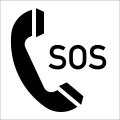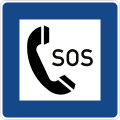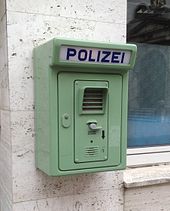Emergency telephone
![]()
The articles Call column, Emergency telephone and Emergency call of the car insurers overlap thematically. So information you are looking for here may also be in the other articles.
You are welcome to participate in the relevant redundancy discussion or directly help to merge the articles or to better distinguish them from each other (→ Instructions).
An emergency telephone (NRT for short) is a telephone device that is used to establish a telephone connection with an emergency control centre in the event of an emergency and to request help there. As a rule, they are located in central public places, in green areas and parks as well as at regular intervals along important road connections. In addition, emergency telephones are located in places where dangerous situations can occur more frequently (such as in lifts, tunnels or at bathing beaches).
The use of the emergency telephone is easy to understand and free of charge. In order to make the emergency telephone clearly visible from afar, the housing is given a conspicuous signal colour and corresponding lettering (such as SOS or emergency call). However, the colour scheme varies around the world. Signposting (if necessary also with distance information) enables the person seeking help to find the emergency telephone more quickly.
Dedicated emergency telephones can only be used for calls to rescue control centres, but emergency telephones are often also part of conventional public payphones. In Germany, telephone booths with an emergency call function have a special lever for this purpose, with which the emergency call can be dialled free of charge. In German telephone boxes, a distinction is made between calling the police and alerting the fire brigade.
With the advent of mobile telephony and the widespread availability of mobile phones, the importance of emergency telephones has declined. High operating and repair costs (mostly due to vandalism) have led to a decline in the use of emergency telephones.
A further development of the emergency telephone for senior citizens or disabled people is called a home emergency telephone. In rare cases, emergency telephones also offer the possibility of telephone counselling. For example, corresponding devices are located at bridges or cliffs with a high suicide rate.

Emergency call box in a subway station
History in Germany
In 1924, 30 police street detectors were installed in the streets of Berlin for the first time. Police officers on street surveillance duty were able to contact the responsible police station by means of the detectors connected to the telephone network. This served, for example, to request assistance from a raiding squad, of which there were 18 on standby in Berlin. The precinct could also call the officer on duty on the street by means of a signal bell. After positive experiences, the Prussian Ministry of the Interior decreed the general installation of this system in 1926.
As a further development of such street detectors from the Weimar Republic, an emergency call device for alerting the police free of charge by the population was presented at the International Police Exhibition in Essen in 1956. This so-called "iron guard" was widely used. In North Rhine-Westphalia, for example, up to 3,000 of the light green pillars were installed long before a uniform, free emergency call was possible, for example from telephone boxes. The iron policeman was about 2.20 metres high and marked with an illuminated line of lettering "Polizei" (Police) or "POLIZEI + FEUER" (POLICE + FIRE) on the roof. The top of the column formed a yellow rotating beacon. It was activated when a citizen used a hands-free device to contact the police by pressing a toggle switch. The control centre could in turn call each individual call column, whereupon the rotating beacon signalled the call to police officers on the spot. The "iron policeman" is still in service today. Newer models are made of plastic, have red instead of light green color, the toggle switch is replaced by a push button and the rotating beacon is missing.
With similar telecommunication technology and operation, but housed in a box, police call boxes provided a means of calling for help in front of police stations that were not permanently manned.
In 1955, emergency call boxes began to be installed on German motorways. Since 1999, the emergency call boxes have been polled by GDV Dienstleistungs-GmbH (GDV DL) of the German Insurance Association.
· _mit_Pfeil,_StVO_1970.svg.png)
Sign 360d: Telephone (emergency call, alternative representation)
· ,_StVO_1970.svg.png)
Traffic sign 360d: Telephone (emergency call) in use since 1971
· 
RWBA symbol: Emergency call pillar as of 1992
· 
Traffic sign 365-51: Emergency call point from 2006 and since 2009
· 
Directional arrow on a delineator to the next emergency call point

Historical emergency call column "iron guard", exhibited at the German Police University
Functionality in Germany
Incoming emergency calls are received by the emergency call of the car insurers. They are forwarded to the relevant rescue coordination centre. Breakdown reports are forwarded to the required breakdown service. The responsible telecommunications authorities are responsible for the technical maintenance of the emergency telephones on the motorways.
At one time, there were around 7,000 emergency call boxes on federal and rural roads in Germany, operated by the Björn Steiger Foundation and the Jürgen Pegler Foundation. The query was made either by the emergency call of the car insurers or by the responsible police or rescue control center. On 29 June 2011, the Björn Steiger Foundation announced that the pillars would be dismantled in all federal states except Baden-Württemberg by the end of 2011. By mid-2011, there were already only 2,000 Björn Steiger Foundation emergency call pillars still in operation. They could no longer be financed and had become superfluous due to the increasing use of mobile telephones.
On the other hand, no binding decision has yet been taken on the whereabouts of the approximately 16,000 emergency call pillars on German motorways; for the time being, newly constructed sections will continue to be equipped with emergency call pillars and the existing stock will be maintained. Furthermore, modernisation measures are currently being carried out on the central technology. In addition, three study projects have been launched to determine whether the infrastructure of the motorway emergency call network could be used for more advanced traffic technology in the future. Two of these projects are currently in the status of a feasibility study. Only one of the projects is expected to be tested in practice on the open road in the medium term.
The statistical call numbers of about 700 actuations per day show a clear need. Especially at peak travel times, the emergency call boxes are still in heavy use. Even when the mobile networks are overloaded (e.g. in the event of a major emergency or a defective fixed network), the number of calls in the corresponding radius increases significantly. A significant increase in the number of calls is also recorded in the event of severe frost.
The most frequently used emergency call pillar, with 263 emergency calls in 2016, was a pillar on the A5 between Weiterstadt and Langen/Mörfelden-Walldorf at kilometre 513.3. A total of 53,000 emergency calls were made in 2016.
When using some emergency call pillars (e.g. on the motorways), it is important to communicate the kilometre number of the current road section in order to clearly define your own position. In order to find the nearest emergency call pillar, small directional arrows are attached to the delineators to indicate where the nearest pillar is located.
Technically, the system - just like fire alarms - is considered a "special means of communication", as it meets different requirements than standard landline telephones: Among other things, line paths of up to 60,000 meters are laid without amplification. Modern emergency telephones can contact an emergency control centre via ISDN, Ethernet (IP telephony) and also via GSM. With these devices, a location identifier is also transmitted. All currently operated generations should be able to transmit the location of the telephone in the event of an emergency call. New generations starting with the ANE 90 model are capable of simple polling, which periodically checks the availability of the phone. The current generation ANE 2000 also has an automatic function check. It can check itself (including the speaker and microphone), independently sets the necessary gain and readjusts it if necessary. It is also possible with this model to assign different receivers to the breakdown button and the emergency call button.
The ANE80 emergency call stations already have location signalling, but this is susceptible to interference. The determination of operational readiness is only possible through a test call. The last bastion for ANE80 technology nationwide is the A95, south of Munich. In the course of summer 2018, ANE2000 emergency call pillars will be installed here.
Emergency telephones based on GSM are also occasionally in use, mostly as a construction site emergency solution. Telephones with Voice-over-IP technology are not yet in widespread use.
The problem with VoIP emergency call pillars (e.g. ANE3000) is the relatively high power requirement of the network components, which must also function in the event of a power failure. This makes this particular type only suitable for limited areas (e.g. road tunnels).
Emergency telephones located outside motorways are usually connected to the rescue control centre or the police by means of the Deutsche Telekom cable network. Telephones operated by the Björn Steiger Foundation are connected to a call center via the mobile network.
Deutsche Bahn AG operates its own emergency telephones, some of which are connected by cable, but also via GSM-R.

Close-up of an emergency call column

Police detector of the Neumann company, Mülheim (Ruhr) in front of the Aachen police station Jesuitenstraße, 2015
Search within the encyclopedia